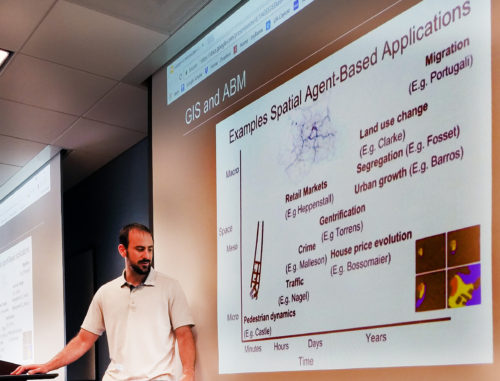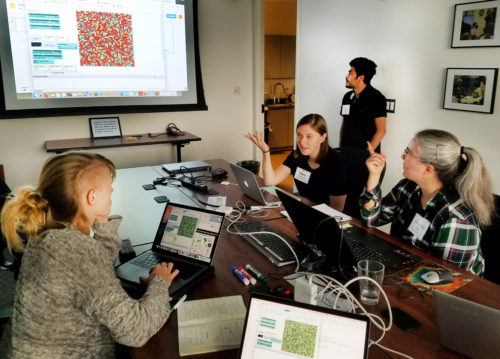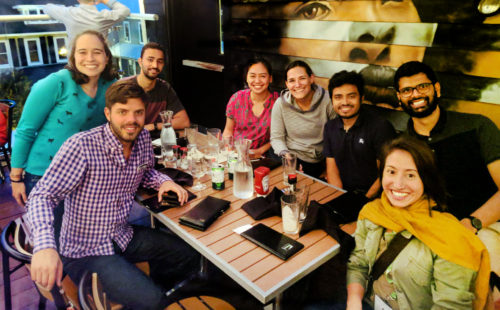Understanding the dynamics and interdependencies of socio-ecological systems through models
Vanessa Vargas-Nguyen ·The Integration and Application Network (IAN) has been trying to evolve its work so that its societal impact can go beyond science communication and integration. Our recent delve into transdisciplinary science necessitates that we not only incorporate its concepts into our work but that we explore and adapt tools currently being used in the field. Recognizing that everything is interconnected and that human decision-making and behavior plays an important role, tools that we are currently exploring and incorporating include: Geographic Information Systems (GIS), System Dynamics Modeling, Social Network Analysis, and Cultural Analysis. An emerging tool that can incorporate these is Agent-based Modeling (ABM). In this blog, I will give an introduction to ABM by describing my participation in the National Socio-Environmental Synthesis Center's (SESYNC) short course on Spatial Agent-Based Modeling last summer, which was taught by Dr. Nicholas Magliocca, Assistant Professor in the Department of Geography at the University of Alabama. Along with the "Introduction to Social Network Analysis" short course taught by Dr. Lorien Jasny (which I participated in last year), this course has been regularly offered at SESYNC as a tool in studying and understanding socio-environmental systems.

Agent-based Modeling (ABM) is computer simulation that explicitly represents individual heterogeneity and interactions. An agent is an autonomous, adaptive decision-making entity that interacts with its environment and other agents through prescribed behavioral rules to produce emergent system-level patterns. Some major differences from other modeling approaches include: (1) algorithms are grown, not solved; (2) agents and environment are fully heterogeneous; (3) artificial intelligence is used; (4) discrete event simulation, meaning each event occurs at a particular instant in time and marks a change of state in the system; and (5) emergence.
Some of the outcomes of ABM include casual mapping, model scoping, hypothesis testing, and collaborative model-based problem-solving. ABM is used to design intervention; it is not used to make a prediction or empirical validation, but instead, it is meant to contribute to our understandings and explore future scenarios. Based on Dr. Magliocca's lecture, ABMs should be used when adaptive behavior, outcome distributions, or behavioral theories are the objects of study, and when heterogeneity and emergence matter. A wide range of phenomena has been modeled with ABMs including disease modeling, migration, population dynamics, community resource management, and many others. Below is an excellent short documentary showing how agent-based computer simulation can be used.
A documentary around the lives of a prehistoric virtual family using agent-based computer simulations. Credit: Simulados by BCS CNS (YouTube), licensed under Creative Commons.
The 5-day short course served as an introduction (crash course!) to the theory and practice of spatially-explicit ABM. Lectures were combined with tutorials in building models using NetLogo, with the goal of equipping students with the necessary knowledge to conceptualize, build, and analyze ABMs. The course was pretty intensive with dense lectures and daily homework and readings. However, there was enough interaction with fellow students including the incorporation of games and breakout groups. Part of our homework and continuing project is to develop a model description, and one of the most important aspects of that is to determine what the purpose of our model would be.
What I envisioned to be the use of ABM for the work that we do is for stakeholder engagement and collaborative learning. I believe ABM would be useful after the report card process in making recommendations on how to "Raise the Grade" of a system, especially in conjunction with social networks and system dynamics. Decisions and actions of multiple actors and potentially multiple spatial relationships are generally absent from System Dynamics models. However, these things are inherent features of ABMs as they are able to incorporate social/ecological processes and structure, social norms, and institutional factors. Specifically promising is the use of Participatory ABM which involves stakeholders in an iterative process of describing contexts, soliciting decisions, running the ABM, and envisioning scenarios arising from the corresponding decisions. Co-developing and assessing intervention strategies can potentially foster social learning, developing shared understanding that can lead to action. To this end, there are multiple literatures in the use of participatory ABMs in natural resource governance that are worth exploring.

However, there is still so much to learn and understand from this continuously evolving field. It is by no means a perfected methodology-- there are multiple criticisms of ABMs. Even among the course participants, not everyone was completely sold on how useful ABM would be in solving real-world problems. Almost all participants were graduate students that were using, will be using, or are contemplating using ABMs in their dissertations, of which their main goal is to contribute to existing knowledge, not application. However, I believe that once we recognize and effectively communicate the limitations of ABMs, the use of participatory ABMs, in particular, has a lot of potential in our work.

About the author
Vanessa Vargas-Nguyen

Dr. Vanessa Vargas-Nguyen is a Science Integrator with the Integration and Application Network and an associate faculty of the Marine Estuarine and Environmental Science Graduate Program. Her current interest is in transdisciplinary approaches, socio-environmental assessments, socio-environmental justice, stakeholder engagement, and adaptive environmental governance. Vanessa is originally from the Philippines and has extensive experience in molecular biology and marine science, specializing in microbial communities and molecular processes associated with Harmful Algal Blooms and shrimp, corals, and human diseases. She has since shifted her focus on how science can benefit society and was conferred with the first Ph.D. under the new Environment and Society foundation of the MEES graduate program. Her dissertation used ethnographic approaches to investigate the role of socio-environmental report cards in transdisciplinary collaboration and adaptive governance for a sustainable future. She received academic training from the University of the Philippines (BSc; MSc) and the University of Maryland (MSc; PhD). She is involved in developing holistic socio-environmental assessments for complex systems such as the Mississippi River and Chesapeake Bay watersheds and is coordinating a multi-year international transdisciplinary research consortium involving the US, Norway, Philippines, Japan, and India.

